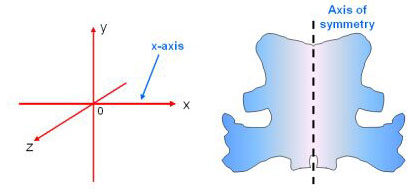Axis

The Earth’s rotation axis is titled at 23.5 degrees to the terminator between night and day.
|
An axis is an imaginary reference line drawn through an object. In astronomy, axis usually refers to the line about which an object rotates. For example, the Earth’s rotation axis passes through the north and south poles, and can be extended onto the celestial sphere where it passes through the north and south celestial poles. All objects that rotate will have a rotation axis, although the direction of this axis may not be fixed with time. |
Two other common types of axes (the plural of axis) are:
- Coordinate axes – the coordinate lines x=0, y=0 and z=0; and
- Axis of symmetry – a line which splits an object into two identical halves as if reflected in a mirror.

left: The x, y and z axes of a three-dimensional coordinate system.
right: This strange looking shape has a vertical axis of symmetry through its centre.
right: This strange looking shape has a vertical axis of symmetry through its centre.
Study Astronomy Online at Swinburne University
All material is © Swinburne University of Technology except where indicated.

